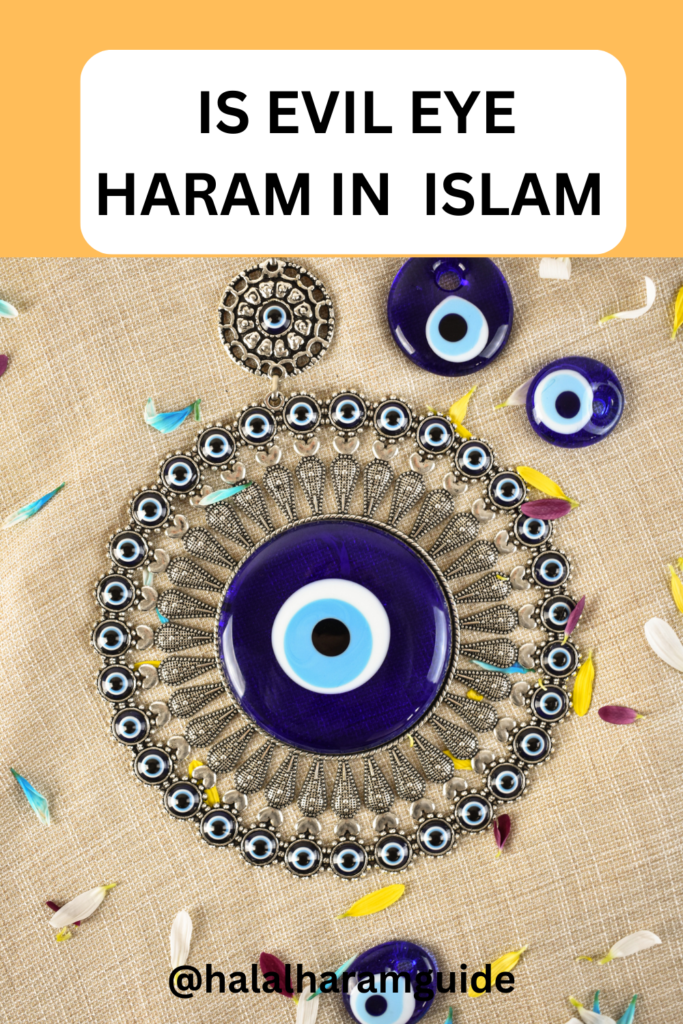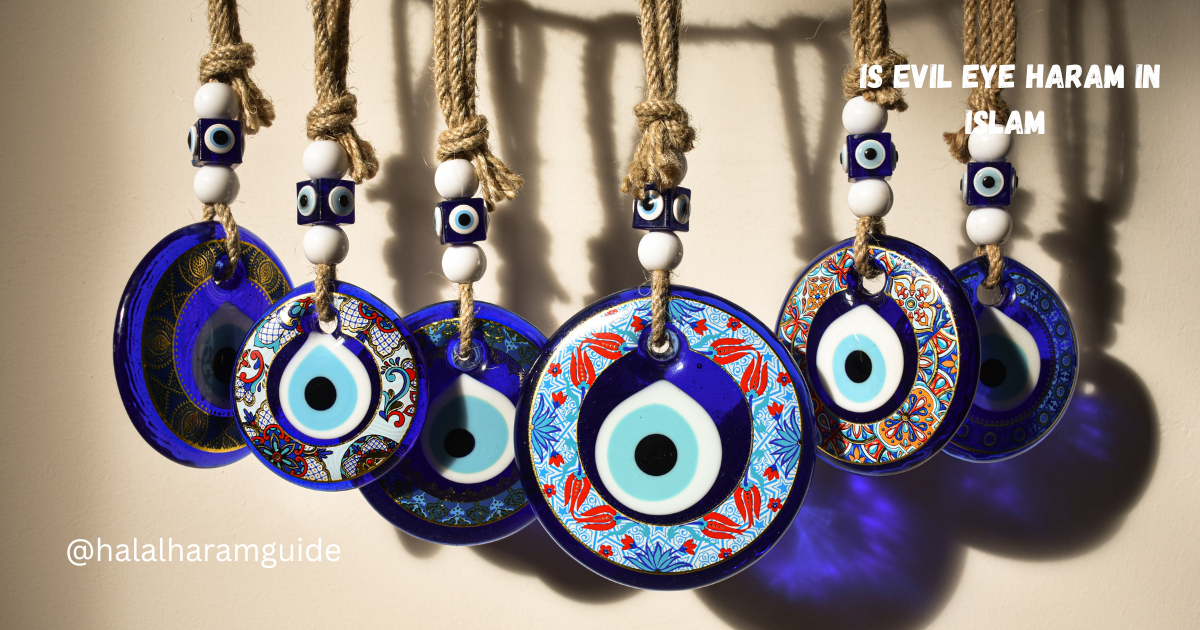Let’s talk about the topic “Is Evil Eye Haram in Islam”
to weThe concept of the Evil Eye has intrigued and puzzled people across cultures for centuries. In Islamic communities, the question of whether the Evil Eye is haram (forbidden) remains a topic of discussion and contemplation.
This belief, often depicted by the 🧿 symbol, involves the idea that envious or negative glances can bring misfortune or harm to individuals. Yet, within the Islamic faith, opinions on its permissibility vary, with some viewing it as a form of superstition and others considering it as a cultural practice.
In this blog post, we delve into the complexities of the Evil Eye in Islam, examining whether it is deemed haram or if it exists alongside a rich tapestry of beliefs and traditions.
What is Evil Eye?
The “Evil Eye” is a belief or superstition found in many cultures around the world. It is often thought to be a malevolent or harmful glance or stare that one person can give to another. This malevolent gaze is believed to bring bad luck, misfortune, or harm to the recipient. The concept of the Evil Eye is rooted in the idea that envious or jealous people can transmit negative energy or ill wishes through their eyes.
The specific beliefs and practices associated with the Evil Eye can vary widely from one culture to another. In some cultures, it is believed that certain individuals have the power to inadvertently cast the Evil Eye, while in others, it is believed that anyone can potentially do so if they harbour negative intentions.
To protect against the Evil Eye, various talismans, amulets, and rituals are used. These protective measures often involve the use of symbols, such as the Nazar or Hamsa hand, which are believed to ward off the harmful effects of the Evil Eye. People may also engage in prayers, rituals, or other forms of spiritual cleansing to protect themselves from its influence.
It’s important to note that the belief in the Evil Eye is a cultural and superstitious concept, and its validity is a matter of personal belief. While some people take it very seriously and incorporate protective measures into their lives, others consider it a superstition without any basis in reality.
Is It Haram To Wear Evil Eyes?
The concept of the Evil Eye and wearing protective symbols like the Nazar or Hamsa hand is rooted in various cultural superstitions and beliefs. Whether wearing such symbols is considered “haram” (forbidden) in Islam or not can vary depending on the interpretation and cultural context.
In Islam, beliefs and practices often align with the teachings of the Quran and the Hadith (the sayings and actions of the Prophet Muhammad). Some Islamic scholars and authorities may view the belief in the Evil Eye and the use of talismans or amulets as superstitions that go against the monotheistic principles of Islam. They may argue that relying on these symbols for protection is a form of shirk, which is the sin of associating partners with Allah (God).
However, opinions on this matter can differ among Muslims. Some individuals and communities may incorporate protective symbols like the Nazar or Hamsa hand into their cultural practices without necessarily considering them as religious acts. They may view these symbols as cultural traditions rather than religious beliefs.
Why is it haram to wear an evil eye?
Here are some reasons why some Islamic scholars and authorities may consider it haram:
Associating Partners with Allah (Shirk): Islam is a monotheistic religion that emphasizes the oneness of Allah (God). The belief in the effectiveness of talismans or amulets, such as the Evil Eye symbol, for protection can be seen as a form of shirk, as it implies that the power of these objects is equal to or can supersede the power of Allah. Associating partners with Allah is considered a major sin in Islam.
Reliance on Superstitions: Islam encourages believers to rely on Allah and have faith in Him as the ultimate protector and provider. Relying on superstitions and symbols for protection can be seen as a lack of trust in Allah’s divine protection and can detract from genuine faith and reliance on Him.
Innovation (Bid’ah): Some Islamic scholars may view the use of symbols like the Evil Eye as an innovation in the religion (bid’ah) because it introduces practices and beliefs that were not established by the Prophet Muhammad or the early Muslim community. Islam places a strong emphasis on adhering to the practices and beliefs that were taught by the Prophet and practised by the early Muslims.
It’s important to note that Islamic interpretations can vary among scholars and religious authorities, and different Muslims may hold different views on this matter.
What is the Islamic Perspective: Is the Evil Eye Haram?
The view on this issue can vary among scholars and individuals. Here are some key points to consider:
Lack of Explicit Mention in the Quran: The concept of the Evil Eye and the use of protective symbols are not explicitly mentioned in the Quran. As a result, the Islamic perspective on this matter is derived from interpretations of Islamic teachings, including the Quran and the Hadith (the sayings and actions of the Prophet Muhammad).
Superstition vs. Cultural Practice: Some Islamic scholars view the belief in the Evil Eye and the use of protective symbols as superstitious practices that may lead to the association of partners with Allah (shirk), which is forbidden in Islam. They argue that Muslims should rely solely on Allah for protection and blessings.
Differing Interpretations: Other scholars and Muslims may see the use of such symbols as a cultural tradition rather than a religious act. They may argue that wearing or displaying these symbols is not an act of shirk but rather a form of protection against negative energies, and it doesn’t necessarily contradict Islamic monotheism.
Intent Matters: In Islam, intent matters when it comes to religious actions. If an individual wears a protective symbol with the belief that it holds some inherent power to protect them, it could be seen as problematic. However, if they wear it as a cultural accessory without ascribing supernatural powers to it, it may be viewed differently.
Local Variations: The acceptance or rejection of the belief in the Evil Eye and related practices can vary significantly among different Muslim communities and cultures. Some cultures may place a strong emphasis on these beliefs, while others may not give them much importance.
Is Belief in the Evil Eye Forbidden (Haram) in Islam?
In Islam, the belief in the Evil Eye is a matter of interpretation and is not explicitly forbidden (haram) in and of itself. The concept of the Evil Eye, which involves the belief in the harmful effects of envy or negative glances, is not mentioned in the Quran. Consequently, the Islamic perspective on this belief is derived from interpretations of Islamic teachings, including the Quran and the Hadith (the sayings and actions of the Prophet Muhammad).
Some Islamic scholars and authorities caution against placing too much emphasis on the belief in the Evil Eye, viewing it as a form of superstition that could lead to the association of partners with Allah (shirk), which is strictly forbidden in Islam. They argue that Muslims should place their trust in Allah alone for protection and blessings.
Exploring the Concept of ‘Nazar’ in Islam: Is it Considered Haram?
The concept of “Nazar” in Islam refers to the belief in the Evil Eye, where it is believed that a person’s envious or negative gaze can bring harm or misfortune to another person. Whether Nazar is considered haram (forbidden) in Islam is a matter of interpretation and can vary among scholars and individuals.
There is no specific mention of Nazar in the Quran, so Islamic perspectives on this concept are often derived from interpretations of Islamic teachings, including the Quran and the Hadith (the sayings and actions of the Prophet Muhammad).
The Evil Eye in Islamic Teachings: Is it a Sin (Haram) or Superstition?
The concept of the Evil Eye in Islamic teachings is a complex matter and can be viewed differently by scholars and individuals. Whether it is considered a sin (haram) or superstition depends on one’s interpretation of Islamic teachings.
Whether the concept of the Evil Eye is considered a sin (haram) or superstition in Islam is not universally agreed upon. It depends on individual beliefs, cultural practices, and interpretations of Islamic teachings.
Some Muslims may see it as a potential source of superstition and advise caution, while others may accept it as a cultural belief without necessarily viewing it as inherently sinful.
As with many religious matters, seeking guidance from knowledgeable religious scholars or authorities within one’s own community can provide clarity on how to approach this concept in accordance with one’s faith.
CONCLUSION
The permissibility of the Evil Eye in Islam is a nuanced and diverse issue, with varying interpretations among scholars and individuals. It is not inherently haram, but rather depends on how it is practised and whether it involves beliefs or actions that contradict Islamic monotheism (Tawhid) or lead to shirk (associating partners with Allah).
Intent and cultural context also play significant roles in determining whether the use of the Evil Eye symbol is considered permissible or potentially problematic within Islamic principles. Therefore, whether the Evil Eye is considered haram in Islam can vary, and Muslims should seek guidance from knowledgeable religious scholars or authorities to ensure their actions align with their faith and beliefs.
FAQ,S
Is the Evil Eye haram?
The belief in the Evil Eye itself is not necessarily haram, but it depends on how it is practiced and whether it involves beliefs that contradict Islamic monotheism (Tawhid) or leads to shirk (associating partners with Allah).
Is the Evil Eye shirk?
Believing in the Evil Eye as a superstition without attributing any real power to it is not necessarily shirk. However, if one believes that the Evil Eye has inherent power equal to or greater than Allah’s power, it could be considered shirk.
Is the blue eye haram in Islam?
The colour of the Evil Eye symbol (often blue) is not inherently haram. What matters is the belief and intent behind its use.
Is it haram to wear the Evil Eye for fashion?
Wearing the Evil Eye symbol for fashion without believing in its supposed protective powers may not be considered haram in and of itself. However, it’s essential to be mindful of cultural sensitivity and context.
Is it haram to wear the Evil Eye even if you don’t believe in it?
If one wears the Evil Eye symbol purely as a fashion accessory and does not attribute any supernatural power to it, it may not be considered haram. Intent plays a significant role in Islamic ethics.
Is the Evil Eye symbol haram?
The symbol itself is not inherently haram; it’s the beliefs and practices associated with it that may raise concerns.
Can Muslims wear Evil Eye symbols?
Some Muslims choose to wear Evil Eye symbols or jewellery as cultural accessories or for personal reasons. The acceptability of this practice can vary among individuals and communities.
Is it haram to wear Evil Eye jewellery even if you don’t believe in it?
Wearing Evil Eye jewellery without believing in its protective powers may not be considered haram, provided it is done with the right intent.
Is it haram to have an Evil Eye in your house?
Having an Evil Eye symbol in your house as a decoration may not be inherently haram if it’s understood as a cultural decoration rather than an object of worship or supernatural belief.
Is wearing an Evil Eye bracelet haram?
Wearing an Evil Eye bracelet may not be haram if it is done for cultural or aesthetic reasons and not as an act of shirk or superstition.
- “Is Lobster Halal? Understanding Its Permissibility”
- “Is Drawing Haram in Islam? Understanding the Perspective”
- “Is Fermented Kimchi Halal? Exploring Kimchi’s Halal Status”
- “Is Collagen Halal? Unveiling the Halal Status of Collagen”
- “Is Wine Vinegar Halal? Unveiling Its Permissibility”


